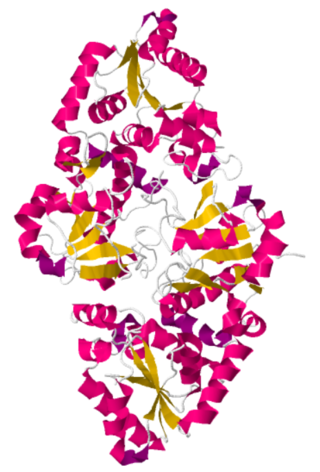Related Research Articles

Glycoproteins are proteins which contain oligosaccharide chains covalently attached to amino acid side-chains. The carbohydrate is attached to the protein in a cotranslational or posttranslational modification. This process is known as glycosylation. Secreted extracellular proteins are often glycosylated.
Glycosylation is the reaction in which a carbohydrate, i.e. a glycosyl donor, is attached to a hydroxyl or other functional group of another molecule in order to form a glycoconjugate. In biology, glycosylation usually refers to an enzyme-catalysed reaction, whereas glycation may refer to a non-enzymatic reaction.
An oligosaccharide is a saccharide polymer containing a small number of monosaccharides. Oligosaccharides can have many functions including cell recognition and cell adhesion.

Fucose is a hexose deoxy sugar with the chemical formula C6H12O5. It is found on N-linked glycans on the mammalian, insect and plant cell surface. Fucose is the fundamental sub-unit of the seaweed polysaccharide fucoidan. The α(1→3) linked core of fucoidan is a suspected carbohydrate antigen for IgE-mediated allergy.

GDP-fucose protein O-fucosyltransferase 1 also known as peptide-O-fucosyltransferase 1 (O-FucT-1) is an enzyme that in humans is encoded by the POFUT1 gene.

GDP-fucose protein O-fucosyltransferase 2 (POFUT2) is an enzyme responsible for adding fucose sugars in O linkage to serine or threonine residues in Thrombospondin repeats. The protein is an inverting glycosyltransferase, which means that the enzyme uses GDP-β-L-fucose as a donor substrate and transfers the fucose in O linkage to the protein producing fucose-α-O-serine/threonine.

Glycosyltransferases are enzymes that establish natural glycosidic linkages. They catalyze the transfer of saccharide moieties from an activated nucleotide sugar to a nucleophilic glycosyl acceptor molecule, the nucleophile of which can be oxygen- carbon-, nitrogen-, or sulfur-based.
hh, or the Bombay blood group, is a rare blood type. This blood phenotype was first discovered in Bombay by Dr. Y. M. Bhende in 1952. It is mostly found in the Indian sub-continent and Iran.

Sialyltransferases are enzymes that transfer sialic acid to nascent oligosaccharide. Each sialyltransferase is specific for a particular sugar substrate. Sialyltransferases add sialic acid to the terminal portions of the sialylated glycolipids (gangliosides) or to the N- or O-linked sugar chains of glycoproteins.
The Lewis antigen system is a human blood group system. It is based upon two genes on chromosome 19: FUT3, or Lewis gene; and FUT2, or Secretor gene. Both genes are expressed in glandular epithelia. FUT2 has a dominant allele which codes for an enzyme and a recessive allele which does not produce a functional enzyme. Similarly, FUT3 has a functional dominant allele (Le) and a non-functional recessive allele (le).
In enzymology, a 3-galactosyl-N-acetylglucosaminide 4-alpha-L-fucosyltransferase is an enzyme that catalyzes the chemical reaction
In enzymology, a 4-galactosyl-N-acetylglucosaminide 3-alpha-L-fucosyltransferase is an enzyme that catalyzes the chemical reaction
In enzymology, a galactoside 2-alpha-L-fucosyltransferase is an enzyme that catalyzes the chemical reaction
In enzymology, a glycoprotein 3-alpha-L-fucosyltransferase (EC 2.4.1.214) is an enzyme that catalyzes the chemical reaction
In enzymology, a glycoprotein 6-alpha-L-fucosyltransferase (EC 2.4.1.68) is an enzyme that catalyzes the chemical reaction

Galactoside 3(4)-L-fucosyltransferase is an enzyme that in humans is encoded by the FUT3 gene.

Galactoside 2-alpha-L-fucosyltransferase 1 is an enzyme that in humans is encoded by the FUT1 gene.

Congenital disorder of glycosylation type IIc or Leukocyte adhesion deficiency-2 (LAD2) is a type of leukocyte adhesion deficiency attributable to the absence of neutrophil sialyl-LewisX, a ligand of P- and E-selectin on vascular endothelium. It is associated with SLC35C1.
O-linked glycosylation is the attachment of a sugar molecule to the oxygen atom of serine (Ser) or threonine (Thr) residues in a protein. O-glycosylation is a post-translational modification that occurs after the protein has been synthesised. In eukaryotes, it occurs in the endoplasmic reticulum, Golgi apparatus and occasionally in the cytoplasm; in prokaryotes, it occurs in the cytoplasm. Several different sugars can be added to the serine or threonine, and they affect the protein in different ways by changing protein stability and regulating protein activity. O-glycans, which are the sugars added to the serine or threonine, have numerous functions throughout the body, including trafficking of cells in the immune system, allowing recognition of foreign material, controlling cell metabolism and providing cartilage and tendon flexibility. Because of the many functions they have, changes in O-glycosylation are important in many diseases including cancer, diabetes and Alzheimer's. O-glycosylation occurs in all domains of life, including eukaryotes, archaea and a number of pathogenic bacteria including Burkholderia cenocepacia, Neisseria gonorrhoeae and Acinetobacter baumannii.
N-glycosyltransferase is an enzyme in prokaryotes which transfers individual hexoses onto asparagine sidechains in substrate proteins, using a nucleotide-bound intermediary, within the cytoplasm. They are distinct from regular N-glycosylating enzymes, which are oligosaccharyltransferases that transfer pre-assembled oligosaccharides. Both enzyme families however target a shared amino acid sequence asparagine—-any amino acid except proline—serine or threonine (N–x–S/T), with some variations.
References
- ↑ Breton C, Oriol R, Imberty A (1998). "Conserved structural features in eukaryotic and prokaryotic fucosyltransferases". Glycobiology. 8 (1): 87–94. doi: 10.1093/glycob/8.1.87 . PMID 9451017.
- ↑ Britten CJ, Bird MI (1997). "Chemical modification of an alpha 3-fucosyltransferase; definition of amino acid residues essential for enzyme activity". Biochim. Biophys. Acta. 1334 (1): 57–64. doi:10.1016/s0304-4165(96)00076-1. PMID 9042366.
- ↑ FAQs.org. "Urinary Tract Infections".
{{cite journal}}: Cite journal requires|journal=(help) - ↑ Medscape.org. "Urinary Tract Infections What Factors Determine the Risk of UTI".
{{cite journal}}: Cite journal requires|journal=(help)